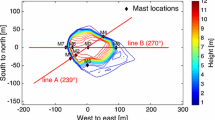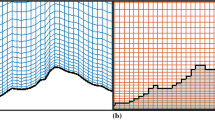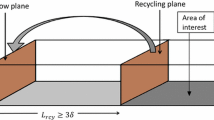Abstract
This paper presents the dry version of a new large-eddy simulation (LES) model, which is designed to simulate air flow and clouds above highly complex terrain. The model is three-dimensional and nonhydrostatic, and the governing equations are sound filtered by use of the anelastic approximation. A fractional step method is applied to solve the equations on a staggered Cartesian grid. Arbitrarily steep and complex orography can be accounted for through the method of viscous topography. The dynamical model core is validated by comparing the results for a spreading density current against a benchmark solution. The model accuracy is further assessed through the simulation of turbulent flow across a quasi two-dimensional ridge. The results are compared with wind-tunnel data. The method of viscous topography is not restricted to moderately sloped terrain. Compared to models using curvilinear grids, it allows this model to be applied to a much wider range of flows. This is illustrated through the simulation of an atmospheric boundary-layer flow over a surface mounted cube. The results show that the dry model version is able to accurately represent the complex flow in the vicinity of three-dimensional obstacles. It is concluded that the method of viscous topography was successfully implemented into a micrometeorological LES model. As will be shown in Part II, this allows the detailed study of clouds in highly complex terrain.
Similar content being viewed by others
References
Allen T and Brown AR (2002). Large-eddy simulation of turbulent separated flow over rough hills. Boundary-Layer Meteorol 102: 177–198
Cabot W and Moin P (1999). Approximate wall boundary conditions in the large-eddy simulation of high Reynolds number flow. Flow, Turbulence Comb 63: 269–291
Castro IP and Robins AG (1977). The flow around a surface-mounted cube in uniform and turbulent streams. J Fluid Mech 79(2): 307–335
Clark RA, Ferziger JH and Reynolds WC (1979). Evaluation of subgrid-scale models using an accurately simulated turbulent flow. J Fluid Mech 91: 1–16
Deardorff JW (1972). Numerical investigation of neutral and unstable planetary boundary layers. J Atmos Sci 29(1): 91–115
Douglas J (1962). Alternating direction methods for three space variables. Num Math 4: 41–63
Eichhorn J, Cui K, Flender M, Kandlbinder T, Panhans W-G, Ries R, Siebert J, Trautmann T, Wedi N and Zdunkowski WG (1997). A three-dimensional viscous topography mesoscale model. Contr Atmos Phys 70(4): 301–317
Froehlich J, Rodi W (2001) Introduction to large eddy simulation of turbulent flows. In: Launder B, Sandham N (eds) Closure strategies for turbulent and transitional flows. Cambridge University Press, pp 267–298
Hussein HJ and Martinuzzi RJ (1996). Energy balance for turbulent flow around a surface mounted cube placed in a channel. Phys Fluids 8(3): 764–780
Iizuka S and Kondo H (2006). Large-eddy simulations of turbulent flow over complex terrain using modified static eddy viscosity models. Atmos Environ 40: 925–935
Ishihara T, Fujino Y, Hibi K (2001) A wind tunnel study of separated flow over a two-dimensional ridge and a circular hill. J Wind Eng 89:573–576. The Fifth Asia-Pacific conference on wind engineering
Kanda M, Moriwaki R and Kasamatsu F (2004). Large-eddy simulation of turbulent organized structures within and above explicitly resolved cube arrays. Boundary-Layer Meteorol 112: 343–368
Kapitza H and Eppel D (1986). A 3-D poisson solver based on conjugate gradients compared to standard iterative methods and its performance on vector computers. J Comput Phys 68: 474–484
Kataoka H and Mizuno M (2002). Numerical flow computation around aeroelastic 3D square cylinder using inflow turbulence. Wind Struct 5: 379–392
Krajnovic S, Davidson L (2001) Large eddy simulation of the flow around a three-dimensional bluff body. AIAA paper no. 2001-0432, Reno, NV
Leitl B, Schatzmann M (1999) Generation of high resolution reference data for the validation of micro-scale models. Technical Report Bericht 1443 ISBN 3-18-091443-2, VDI-Kommission Reinhaltung der Luft
Lilly DK (1962). On the numerical simulation of buoyant convection. Tellus 14: 148–172
Lund TS, Wu XW and Squires KD (1998). Generation of turbulent inflow data for spatially-developing boundary layer simulations. J Comput Phys 140: 233–258
MacCormack RW (1969) The effect of viscosity in hypervelocity impact cratering. AIAA hypervelocity impact conference, Paper no. 69-354
Mason PJ (1989). Large-eddy simulation of the convective atmospheric boundary layer. J Atmos Sci 46(11): 1492–1516
Mason PJ (1994). Large-eddy simulation: a critical review of the technique quart. J Roy Meteorol Soc 120: 1–26
Mason PJ and Sykes RI (1978). A simple cartesian model of boundary layer flow over topography. J Comput Phys 28: 198–210
Mason PJ and Thomson DJ (1992). Stochastic backscatter in large-eddy simulations of boundary layers. J Fluid Mech 242: 51–78
Mendez-Nunez LR and Caroll JR (1993). Comparison of Leapfrog, Smolarkiewicz and MacCormack schemes applied to nonlinear equations. Mon Wea Rev 121: 565–578
Moin P and Kim J (1982). Numerical investigation of turbulent channel flow. J Fluid Mech 118: 341–377
Neumann J and Wengle H (2003). DNS and LES of passively controlled turbulent backward-facing step flows. Flow, Turb Comb 71: 297–310
Orlanski I (1976). A simple boundary condition for unbounded hyperbolic flows. J Comput Phys 21: 251–269
Patrinos A and Kistler AL (1977). A numerical study of the Chicago Lake Breeze. Boundary-Layer Meteorol 12: 93–123
Smolarkiewicz PK and Clark TL (1986). The multidimensional positive definite advection transport algorithm: further developments and applications. J Comput Phys 67: 396–438
Smolarkiewicz PK and Grabowski WW (1990). The multidimensional positive definite advection transport algorithm: nonoscillatory option. J Comput Phys 86: 355–375
Straka JM, Wilhelmson RB and Droegemeier KK (1993). Numerical solutions of a non-linear density current: a benchmark solution and comparisons. Int J Num Meth Fluids 17: 1–22
Author information
Authors and Affiliations
Corresponding author
Rights and permissions
About this article
Cite this article
Reinert, D., Wirth, V., Eichhorn, J. et al. A new large-eddy simulation model for simulating air flow and warm clouds above highly complex terrain. Part I: The dry model. Boundary-Layer Meteorol 125, 109–132 (2007). https://doi.org/10.1007/s10546-007-9183-8
Received:
Accepted:
Published:
Issue Date:
DOI: https://doi.org/10.1007/s10546-007-9183-8




